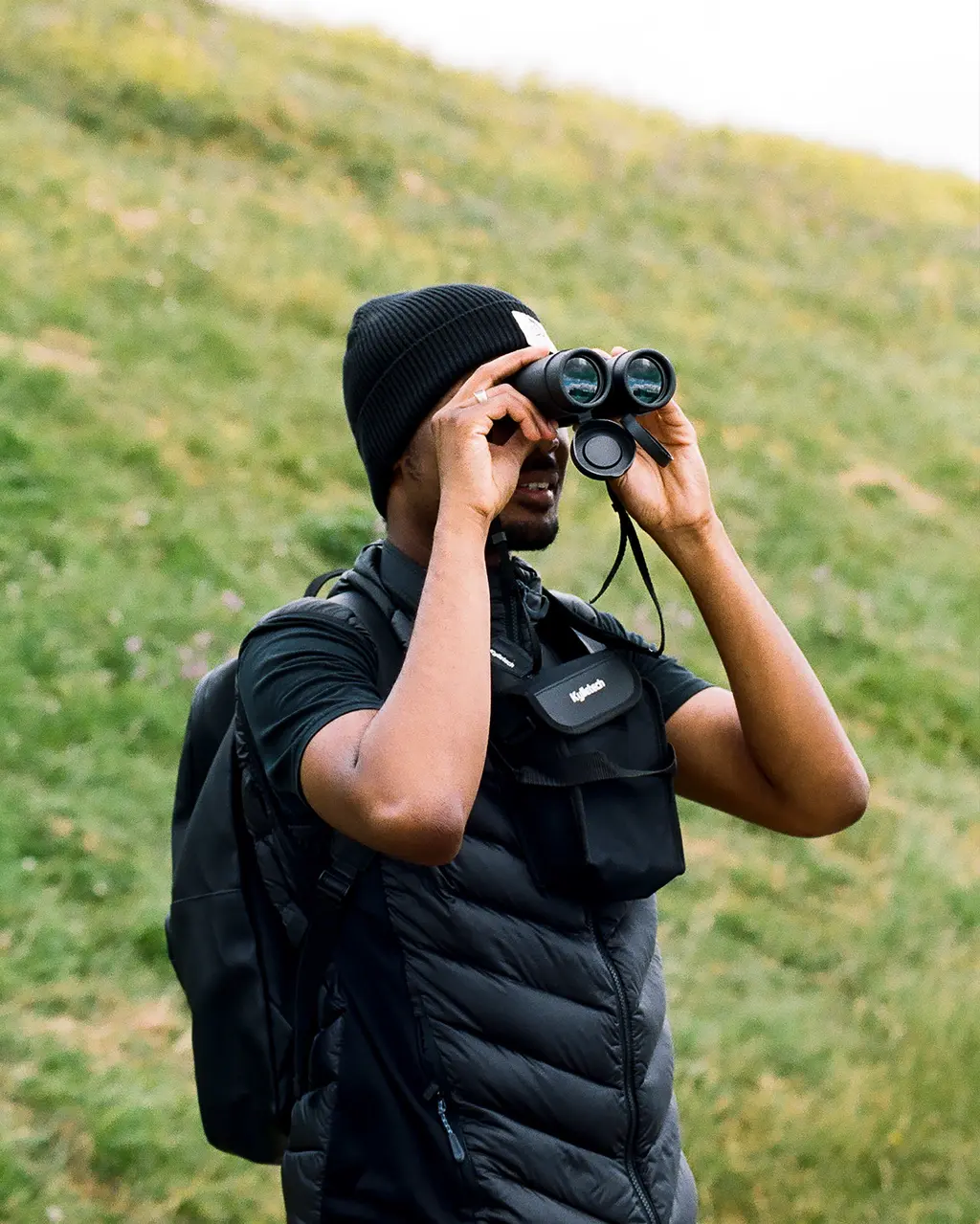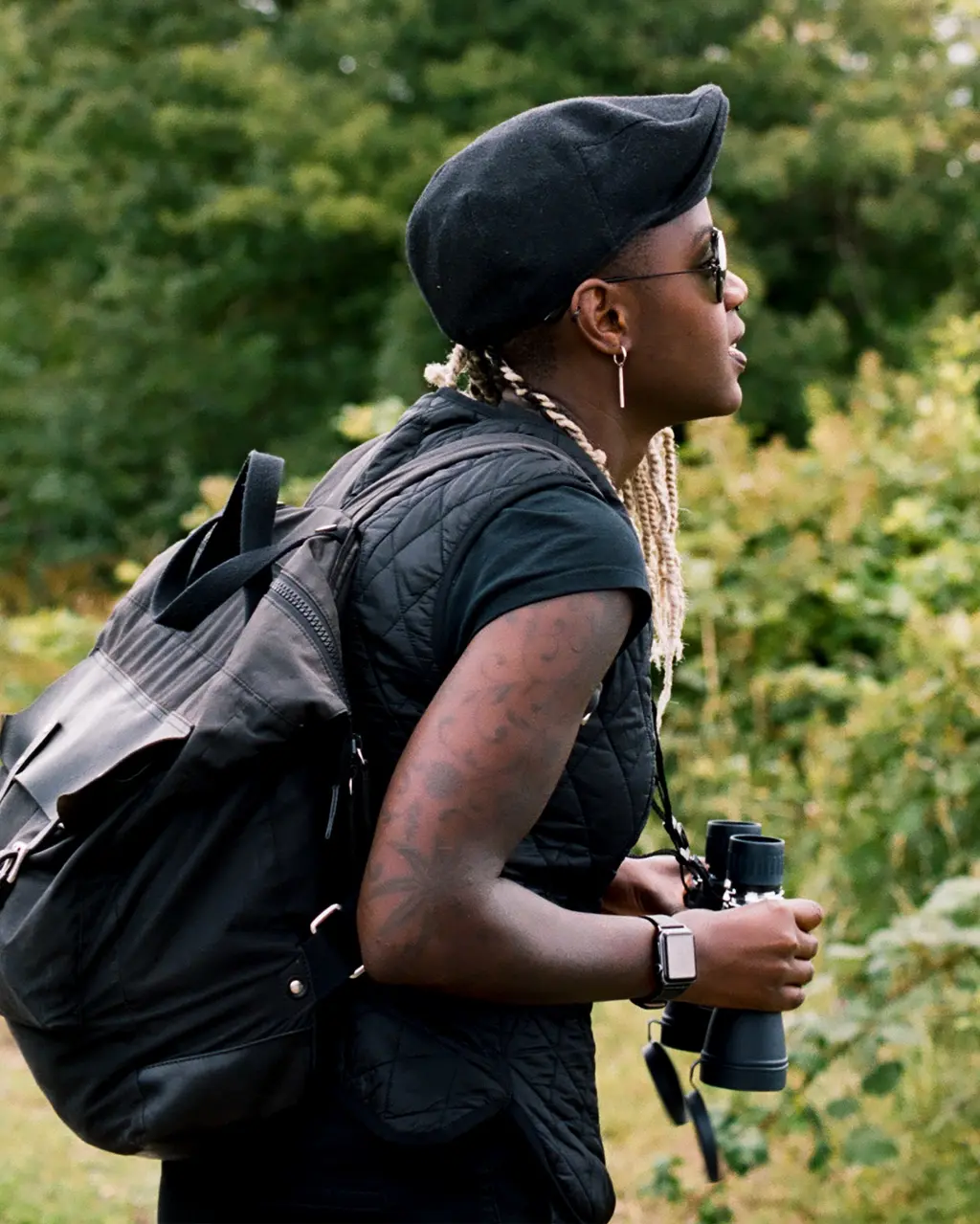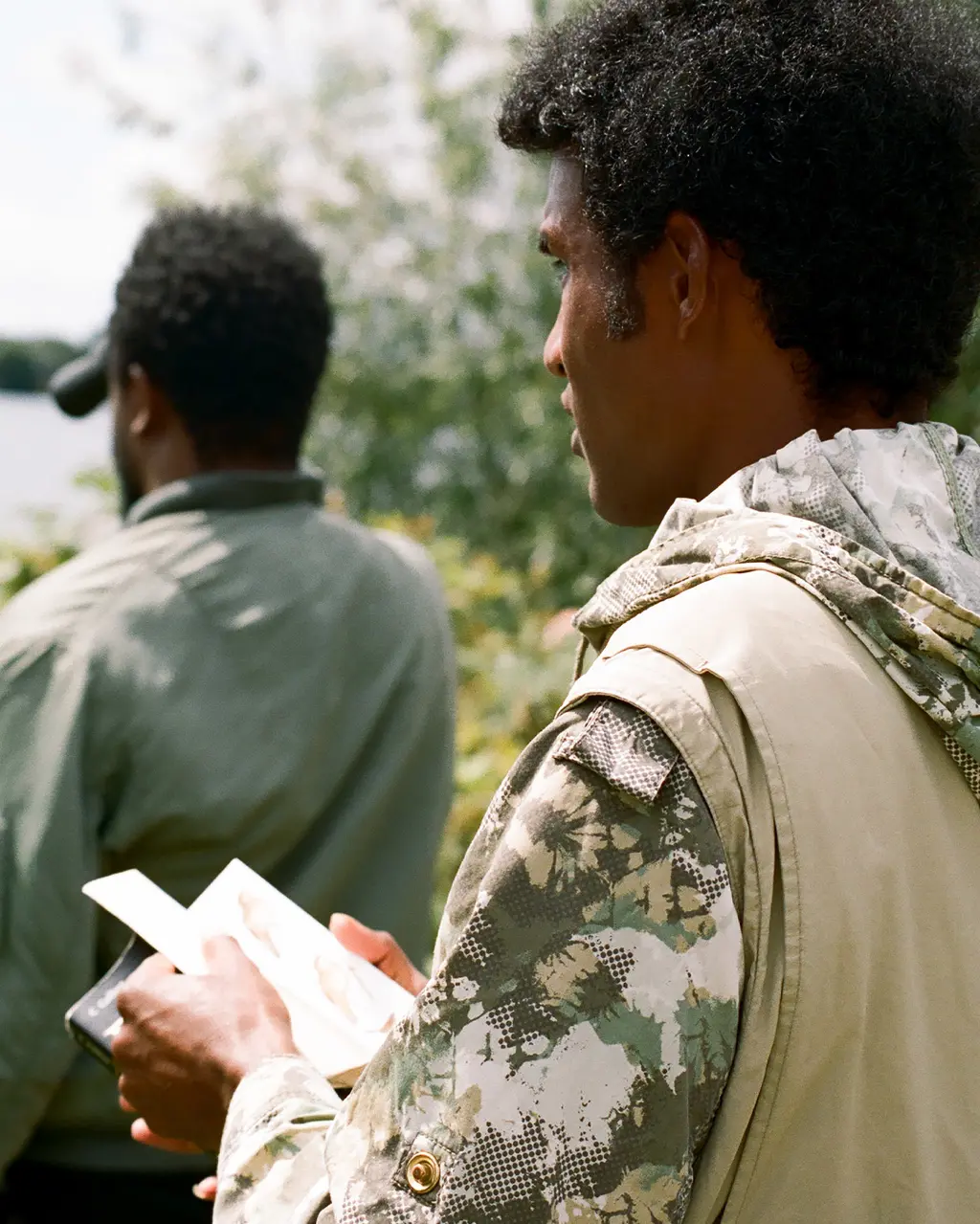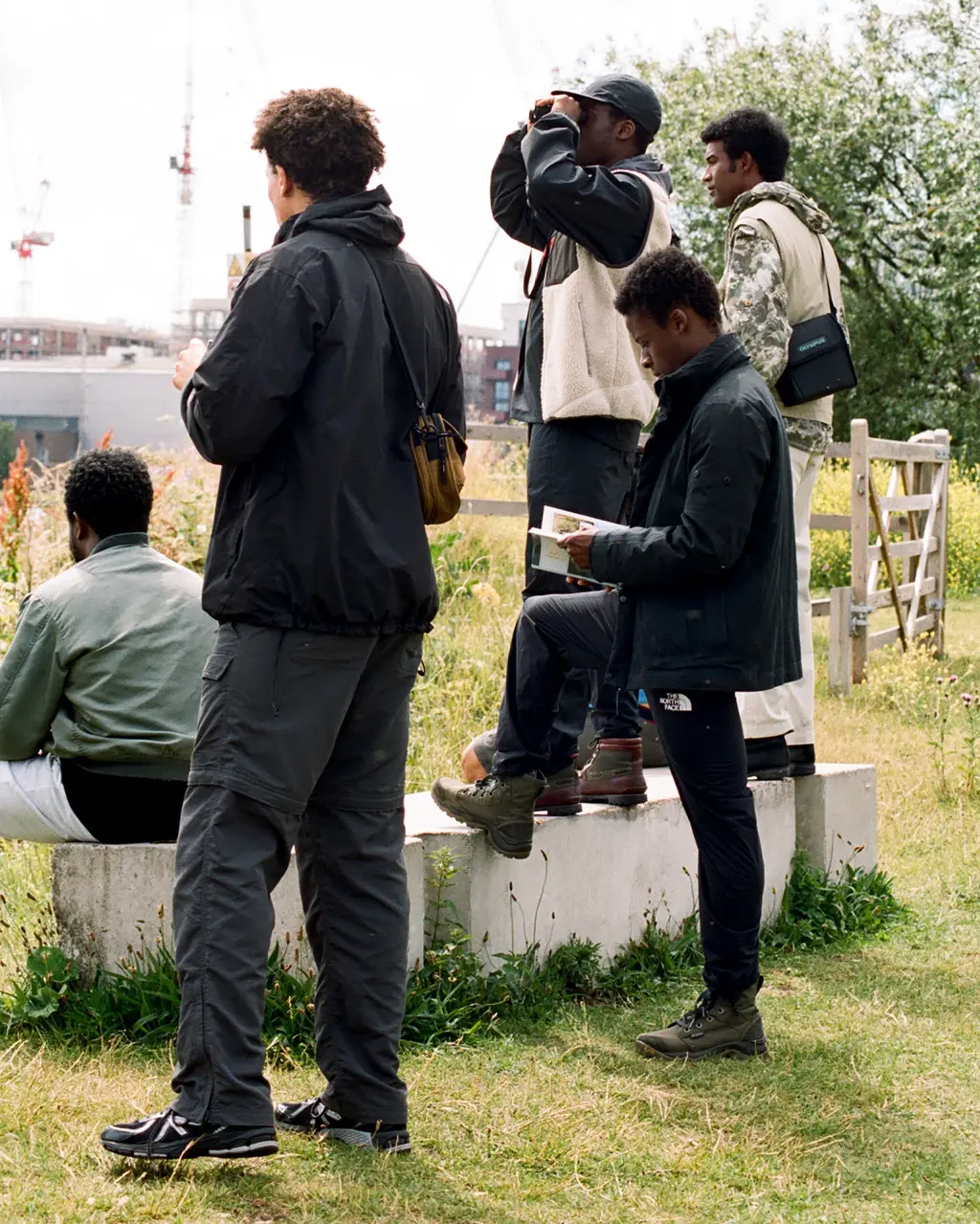Flock Together: the birdwatching club for people of colour

Twenty-twenty has been challenging for everyone, not least for people from the African and Caribbean diasporas. Here, Rainbow Milk author Paul Mendez joins the monthly birdwatching club aiming to show that nature is for everyone.
Society
Words: Paul Mendez
Photography: Danika Lawrence
Article taken from The Face Volume 4 Issue 004. Order your copy here.
I’d never been birdwatching before. But since I moved close to London’s Hampstead Heath two years ago I’ve become much more aware of the birds I’m surrounded by, from parakeets, herons and woodpeckers by day, to tawny owls by night. So, as Black Lives Matter marches swept the world, and governments started easing lockdowns, the offer to join a group of Black birdwatchers on Walthamstow Wetlands in east London felt opportune.
I left the house prepped like an over-protected 11-year-old setting out for their first day at secondary school. On the Overground I sat among several travellers mostly wearing masks. Classical music was playing as I got off at Blackhorse Road and joined the birders.
A group of Black people standing on a street corner on a Sunday morning is a radical act, a protest, especially during this Black spring. The circle opened to accept any Black person coming out of the station. We introduced ourselves as poets, photographers, graphic designers and youth workers. We were men, women, light-skinned, dark-skinned, straight or on the LGBTQ+ spectrum.
Flock Together is a “monthly birdwatching support club combating the under-representation of people of colour in nature”. Started by Nadeem Perera, a 26-year-old Black football coach of Sri Lankan and Jamaican descent, and 35-year-old Ollie Olanipekun, a creative director of Nigerian heritage and founder of agency SUPERIMPOSE, it has an eye on excursions outside London and link-ups with similar clubs. Although I’d never met any of the members before I felt instantly calm, as if we were distant relatives meeting for the first time at a funeral. The past few months could be read in all our faces.
Olanipekun turned up in a fleece gilet and Timberland boots – having bipped at us enthusiastically as he found somewhere to park his blacked-out Land Rover – and handed out pairs of binoculars like sweets. “I’ve been birdwatching myself for maybe a decade, but never seriously. I barely had binoculars. Then I posted a video [of a bird] from my local pond, and someone commented. I thought: ‘This person’s gonna be white, middle-aged…’ Then I clicked on their profile and was like, ‘Whew, you a birdwatcher?’”
That person was Perera, who himself came to birding as a troubled 16-year-old. Having spotted a green woodpecker in an Essex graveyard, he returned the next day to photograph it. His fixation with birds grew and was fully realised a year or so later when a goldcrest (olive green with a blazing orange stripe on top of its head) visited him at his bedroom window, alerting him to his proximity to the secrets of the natural world. Olanipekun – the sort of person who can’t keep still – suggested they set up Flock Together. “The response has been insane,” he told me. “We got donated binoculars, and people saying they wanted to join us.”
Perera – wearing fatigues and initially somewhat intense and serious – explained the wider purpose of Flock Together. “Our two main targets are mental health for people of ethnic minority backgrounds, facilitating a healing process from problems caused by society, and to combat the under-representation of Black people and non-Europeans in the natural world,” he said.
The group is about much more than birds. “You start with the birds but then you realise birds need insects, insects need trees, birds need trees, the temperature dictates insects’ behaviour, which affects birds. We are afforded more perspective and find ourselves better equipped to deal with what’s out there.”

Early on in the pandemic it became clear that Black people in the UK and US were more likely to die from Covid-19 than white people. At home, with most of us on furlough, we read books, joined the Verzuz producer battles on Instagram Live (kicked off by Timbaland and Swizz Beatz) and buried our faces in I May Destroy You. We became a captive audience to a montage of racial injustices that happen every day, whether we’re watching or not.
Time felt as if it had taken on amorphous qualities – compounded by the eons it seems to take to bring to justice those who visit violence on Black bodies – and on 25th May, while public outcry was rising over the murders of Ahmaud Arbery and Breonna Taylor, we were so shaken by two further incidents involving Black people that it seems, in hindsight, like a trick of the mind that they happened on the same day.
In Central Park, New York City, we saw Christian Cooper, a Harvard-educated science writer, comics author, ornithologist and LGBTQ+ activist, birding in the section of the park known as the Ramble. He took out his phone to film a woman who’d become aggressive after he reminded her that dogs were supposed to be leashed there.
We watched her take out her phone and, while handling her dog abusively, tell Cooper that she was going to call the police and inform them that “an African-American man” was threatening her life, knowing what the police response would likely be to hearing the words “African-American man” – erasing Cooper’s individual identity in a second – threatening a white woman.
Meanwhile, in Minneapolis, a teenage grocery store worker called the police after George Floyd, a 46-year-old Black Texan, tried to pay for some cigarettes with what was found to be a counterfeit bill. Floyd was a big man and compliant, but claustrophobic. He refused to get into the back of a police car, so he was pulled out of his truck and pinned to the ground. Despite pleading for his life he was held face down, with an officer’s knee on his neck, for eight minutes and 46 seconds.
We watched as a dead Black man was lifted onto a stretcher and into an ambulance. Television news showed his last moments, night after night. We saw white people, newly aware of their privilege, talking on social media about how they had once been arrested for trying to pay for something with a counterfeit note, a story they survived to sometimes tell at parties.
The American writer James Baldwin learned, as a young man, that “being a Negro meant, precisely, that one was never looked at but was simply at the mercy of the reflexes the colour of one’s skin caused in other people”. We can be almost certain that Arbery, Taylor and Floyd would not now be dead if they were white.
Black Lives Matter grew into one of the biggest civil rights movements in history, as people all over the world woke up to the structural and institutional inequalities that undermine every aspect of Black humanity, perhaps deepening the trauma of Black people who have lived it for centuries and felt powerless to do anything about it.
Studies have shown that these stark and regular reminders of the Black body’s vulnerability to white brutality have “negative mental health consequences” for Black people. We might bracket this new era of filmed deaths at the hands of police with older traumas suffered by African-Americans, such as lynchings, medical experiments, forced sterilisation and slavery itself.


But we have also seen an unprecedented response by Black people to push back boundaries and create our own spaces – not only to deal with trauma but to actively appreciate and love life.
Hence why we found ourselves on Walthamstow Wetlands on a cloudy and chilly summer solstice. The wetlands have only been open for a couple of years and have a much swampier, wilder feel than other London green spaces. We were inundated with midges, and the swifts darting around feeding on them reminded me of the bats on Hampstead Heath.
“We’re lucky to see them because they’re here for a very short time,” Perera said. Neither he nor Olanipekun claim to be experts but they could have fooled me. “The swifts fly through Spain, North Africa, then eventually make their way down to the southern parts of Africa. They live in a perpetual summer. It’s important to document migratory swifts’ activity, as they offer a great ecological service to us.”
We filmed a little egret dipping its spear-like beak in and out of the water. A tufted duck looked apparently dead, then merely injured, but we finally realised it was just drying its wings. I started Googling collective nouns for certain species as we walked by a gaggle of Canada geese, the new birders in free and easy conversation with each other, every so often moving out of the way at the sound of a bicycle bell or replying “good morning” to a curious passer-by.
We realised what we looked like – a “gang” of a dozen people of colour – and that white users of the wetlands must be wondering what we were doing there: were we filming a music video or about to stage a guerrilla Black Lives Matter protest?
While Black people are just as likely to harbour a passion for birdwatching, gardening, fishing, hiking or other outdoor activities as white people, white people in rural or semi rural areas do not expect to see Black people out and about in “their” spaces. Statistics show that 98.1 per cent of Black people in England and Wales live in urban areas, and the impression people in rural areas have of Black people is often what’s fed to them by the media.
I found a BBC News report showing two sides of British life in response to the partial end of lockdown particularly triggering. On the one hand there was NikeTown, Oxford Circus, on its first day of reopening. A queue of mostly young Black men – faces covered – crushed up against each other ready to swarm as soon as the doors were opened. On the other, there was a class of perfect-looking white schoolchildren, all suitably socially-distanced and washing their hands, singing Happy Birthday to the blond prime minister.
An initiative called #BlackBirdersWeek was set up in the US in response to the Central Park birdwatching incident to show that Black people belong in the natural world too. But it remains a difficult concept for some to accept.
Perera had us take out our pencils and notebooks as we witnessed a great crested grebe picking out branches from some undergrowth to carry back to its nest. “Every bird we see, we’re going to document,” he said. “Each species, how many of each one, what time we saw it, and the general area where we saw it. We upload our data to bto.org [the British Trust for Ornithology website] and this data can actually prevent new construction on these spaces. We can show how much wildlife activity is going on here and help prevent building development.”
For Perera, everything comes down to belonging with, and upholding, the natural environment. “This is something for us, that can help us,” he said. As a former model who recalls being told, aged 18, by a casting agent: “Sorry, we already have the Black guy” for a New York runway show, he has also faced ridicule from friends and family for his birding passion. “There is no discrimination in the natural world. This is open for all of us. We are all of this thing called nature. This is the perspective afforded to us through the work we’re doing today.”


Perhaps the greatest challenge we as members of the African diaspora face in the 21st century is to see our identities, our communities, our histories and our futures for ourselves and by ourselves – and to not be concerned about what other people think of us, but to actively participate in our own lives. That includes confronting fears – something we’re used to.
“Everything I’m scared of, I do,” Kieron Rennie, a 29-year-old performance poet and creative consultant, told me. “I’m really shy and introverted, but I perform. I really don’t like public speaking but I make it my mission. It’s helpful. After a while you find your way of doing it, and you own being shy.”
Rural spaces can be inhibiting for people who are expected to be confined to the inner cities but, as elsewhere in life, fears can be overcome within an inclusive collective presence, and through the sharing of experiences. After an hour of watching and noting pochards, common shelducks, cormorants, sand martins, herring gulls and pied wagtails (all of which Perera reeled off without the need of a book), we sat down to hear Rennie perform his poetry and to talk as a group.
I was struck by how comfortable people felt opening up to a circle of relative strangers. “I can see on everyone’s faces what we’ve been dealing with for the last few weeks, few months,” said Olanipekun. “We know what each other’s experience has been, so we take a giant leap forward together, knowing that we can start on a level.”
Energised, we hung near the wetlands’ exit, tying up conversations. A white family from Kent visiting for the first time walked past us, then stopped and turned, smiled, and asked if we were birders and what we had seen today.
“Case in point. We’ve already changed the perception of Black people in nature,” said Olanipekun, excitedly. “They’re gonna go home and say to their families: ‘Guess what I saw today?’”





